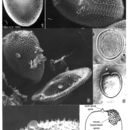Ecology
provided by NMNH Marine Dinoflagellates
P. minimum is a bloom-forming planktonic species. Cosmopolitan in temperate, brackish waters to tropical regions; mostly estuarine, but also neritic (Steidinger & Tangen 1996; Faust et al. 1999). Due to its small size, this species is probably often lost or overlooked in field samples (Dodge, 1982). Cells are active swimmers (Parke & Ballantine 1957). Recently, Stoecker et al. (1997) reported mixotrophy in this species; ingested cryptophytes were observed in cells of P. minimum.
- bibliographic citation
- Faust, Maria A. and Rose A. Gulledge. Identifying Harmful Marine Dinoflagellates. Smithsonian Contributions from the United States National Herbarium, volume 42: 1-144 (including 48 plates, 1 figure and 1 table).
Habitat and Locality
provided by NMNH Marine Dinoflagellates
P. minimum is commonly found along the west coast of the USA, Japan, Gulf of Mexico, Caspian, Adriatic, Mediterranean and Black Seas, and Scandinavian waters; often in large numbers (Dodge 1982; Tangen 1980; 1983; Marasovic et al. 1990).
- bibliographic citation
- Faust, Maria A. and Rose A. Gulledge. Identifying Harmful Marine Dinoflagellates. Smithsonian Contributions from the United States National Herbarium, volume 42: 1-144 (including 48 plates, 1 figure and 1 table).
Morphology and Structure
provided by NMNH Marine Dinoflagellates
P. minimum is a photosynthetic species has golden-brown chloroplasts, one large pyrenoid and two pusules. The nucleus is broadly ellipsoidal and posteriorly situated (Parke & Ballantine 1957; Faust 1974; Dodge 1982).
- bibliographic citation
- Faust, Maria A. and Rose A. Gulledge. Identifying Harmful Marine Dinoflagellates. Smithsonian Contributions from the United States National Herbarium, volume 42: 1-144 (including 48 plates, 1 figure and 1 table).
Nomenclatural Types
provided by NMNH Marine Dinoflagellates
Holotype: Exuviaella minima Schiller, 1933: figs. 33a,
Type Locality: Mediterranean Sea: Gulf of Lion, France
- bibliographic citation
- Faust, Maria A. and Rose A. Gulledge. Identifying Harmful Marine Dinoflagellates. Smithsonian Contributions from the United States National Herbarium, volume 42: 1-144 (including 48 plates, 1 figure and 1 table).
Reproduction
provided by NMNH Marine Dinoflagellates
P. minimum reproduces asexually by binary fission.
- bibliographic citation
- Faust, Maria A. and Rose A. Gulledge. Identifying Harmful Marine Dinoflagellates. Smithsonian Contributions from the United States National Herbarium, volume 42: 1-144 (including 48 plates, 1 figure and 1 table).
Species Comparisons
provided by NMNH Marine Dinoflagellates
P. minimum can be confused with P. balticum; however, the former species differs by its larger size and different shape, and by having only one apical spine and a forked periflagellar collar (Faust et al. 1999).
- bibliographic citation
- Faust, Maria A. and Rose A. Gulledge. Identifying Harmful Marine Dinoflagellates. Smithsonian Contributions from the United States National Herbarium, volume 42: 1-144 (including 48 plates, 1 figure and 1 table).
Species Overview
provided by NMNH Marine Dinoflagellates
P. minimum is an armoured, marine, planktonic, bloom-forming dinoflagellate. It is a toxic cosmopolitan species common in cold temperate brackish waters to tropical regions.
- bibliographic citation
- Faust, Maria A. and Rose A. Gulledge. Identifying Harmful Marine Dinoflagellates. Smithsonian Contributions from the United States National Herbarium, volume 42: 1-144 (including 48 plates, 1 figure and 1 table).
Synonyms
provided by NMNH Marine Dinoflagellates
Exuviaella minima Pavillard, 1916
Prorocentrum triangulatum Martin, 1929
Exuviaella marie-lebouriae Parke and Ballantine, 1957
Prorocentrum cordiformis Bursa, 1959
Prorocentrum mariae-lebouriae (Parke and Ballantine, 1957) Loeblich III, 1970
- bibliographic citation
- Faust, Maria A. and Rose A. Gulledge. Identifying Harmful Marine Dinoflagellates. Smithsonian Contributions from the United States National Herbarium, volume 42: 1-144 (including 48 plates, 1 figure and 1 table).
Taxonomic Description
provided by NMNH Marine Dinoflagellates
P. minimum is a bivalvate species often observed in valve view. Cells are small (14-22 µm long to 10-15 µm wide) and shape is variable: cells range from triangular (Fig. 1), to oval (Figs. 3, 5, 7), to heart-shaped (Fig. 6). Cells are laterally flattened (Fig. 3). A short apical spine is sometimes observable (Figs. 1-4, 7). Valves with short, evenly shaped broad-based spines (about 600-700 per valve) arranged in a regular pattern (Figs. 1-4). These can appear as rounded papillae depending on angle of view. There are two sized pores present: smaller pores are scattered (Figs. 1, 4), while larger pores are located at the base of some peripheral spines. The intercalary band is transversely striated (Figs. 2, 5, 6) (Parke & Ballantine 1957; Faust 1974; Dodge 1982; Steidinger & Tangen 1996). The broad anterior end is truncate with a relatively small, shallow, broadly V-shaped depressed periflagellar area located apically on the right valve, slightly off-center (Figs. 1-7). The periflagellar area bears eight apical platelets and two pores of unequal size: a large flagellar pore and a smaller auxiliary pore (Fig. 2). Adjacent to the flagellar pore is a small apical spine (Figs. 2, 7). Adjacent to the auxiliary pore is a small, curved and forked periflagellar collar (Figs. 1, 2) (Parke & Ballantine 1957; Dodge & Bibby 1973; Faust 1974).
- bibliographic citation
- Faust, Maria A. and Rose A. Gulledge. Identifying Harmful Marine Dinoflagellates. Smithsonian Contributions from the United States National Herbarium, volume 42: 1-144 (including 48 plates, 1 figure and 1 table).
Toxicity
provided by NMNH Marine Dinoflagellates
P. minimum is a toxic species; it produces venerupin (hepatotoxin) which has caused shellfish poisoning resulting in gastrointestinal illnesses in humans and a number of deaths. This species is also responsible for shellfish kills in Japan and the Gulf of Mexico, Florida (Nakazima 1965; Nakazima 1968; Smith 1975; Okaichi & Imatomi 1979; Tangen 1983; Shimizu 1987; Steidinger & Tangen 1996).
- bibliographic citation
- Faust, Maria A. and Rose A. Gulledge. Identifying Harmful Marine Dinoflagellates. Smithsonian Contributions from the United States National Herbarium, volume 42: 1-144 (including 48 plates, 1 figure and 1 table).

